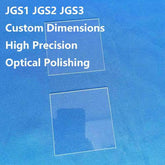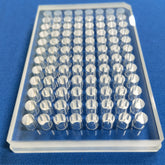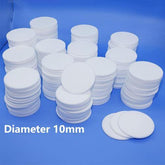How resistant are ultraviolet quartz lenses to chemical corrosion?
Ultraviolet quartz lenses exhibit superior optical performance in the ultraviolet spectral range and are widely used in laser systems, spectroscopic analysis, semiconductor fabrication, and medical devices. Their corrosion resistance constitutes a critical parameter for assessing their suitability and long-term durability. This discussion provides a comprehensive examination of the anti-corrosion characteristics of ultraviolet quartz lenses, focusing on material properties, corrosive environments, and performance in practical applications.
1. Analysis of several corrosive environment that can affect on ultraviolet quartz lenses
While ultraviolet quartz lenses are renowned for their high chemical stability, they are not invulnerable and may be susceptible to corrosion in extreme environments. The following are some of the most common corrosive environments and their effects on ultraviolet quartz lenses.

(1) Acid environment
Ultraviolet quartz lenses demonstrate excellent resistance to most acids (including hydrochloric, sulfuric and nitric acid), however, they are susceptible to corrosion when exposed to high-temperature or high-concentration hydrofluoric acid (HF). Hydrofluoric acids can react with silicon dioxide, forming soluble fluorides which cause lens surface erosion.
(2) Alkaline environment
Ultraviolet quartz lenses exhibit relatively weak corrosion resistance in strongly alkaline environments, including solutions of sodium hydroxide and potassium hydroxide. Alkaline substance can react with the silicon dioxide, potentially leading to surface etching and silicate compound formation.
(3) High-temperature and high-pressure environment
In conditions of high temperature and pressure, there is a possibility of a reduction in the chemical stability of ultraviolet quartz lenses, particularly in the presence of corrosive gases (e.g. chlorine, fluorine).
(4) Radiation environment
Exposure to high-energy radiation, such as ultraviolet rays, X-rays and gamma rays, can cause ultraviolet quartz lenses to undergo structural changes, potentially leading to a decline in performance. However, this kind of change generally does not manifest as obvious corrosion.

2. The anti-corrosion performance of ultraviolet quartz lenses in practical applications
In practical applications, the anti-corrosion performance of ultraviolet quartz lenses enables them to adapt to a variety of harsh environments:
(1) Laser system
In ultraviolet lasers, the lenses need to withstand the irradiation of high-energy ultraviolet light and the possible generation of corrosive gases such as ozone. Ultraviolet quartz lenses exhibit excellent stability and durability under these conditions.
(2) Semiconductor fabrication
In semiconductor fabrication processes, quartz lenses may be exposed to corrosive gases (e.g., hydrogen fluoride, chlorine) or liquid chemicals. Through appropriate engineering design and protective measures, ultraviolet quartz lenses can meet the stringent requirements of semiconductor manufacturing environments.
(3) Medical devices
In ultraviolet disinfection equipment, quartz lenses need to come into contact with high temperatures, high humidity and possible chemical disinfectants. Ultraviolet quartz lenses demonstrate extended operational stability under these demanding conditions.
(4) Spectral analysis
In spectral analysis instruments, ultraviolet quartz lenses may come into contact with various chemical samples. The high chemical stability of the ultraviolet quartz lenses ensures the accuracy of the analysis results and the long-term reliability of the instrument.

3. Measures to improve the corrosion resistance of ultraviolet quartz lenses
(1) Surface coating
The corrosion resistance of the ultraviolet quartz lenses can be further enhanced by coating them with anti-corrosion films (such as magnesium fluoride, titanium dioxide, etc.) .
(2) Design optimization
In lens design, sharp edges or weak areas should be avoided as much as possible to reduce the local concentration of corrosion.
(3) Environment control
During use, try to control the temperature, humidity and concentration of chemical substances in the environment as much as possible to reduce the risk of corrosion.
(4) Maintenance routine
Regularly clean and inspect the surface of the lens, and promptly remove any harmful substances that may adhere to it.
4. Conclusion
Ultraviolet quartz lenses demonstrate exceptional corrosion resistance in most environments owing to their high chemical stability, thermal resistance, and low hygroscopicity. However, under extreme conditions—including exposure to high-concentration hydrofluoric acid, strongly alkaline solutions, or high-temperature/pressure corrosive gases—their corrosion resistance may become compromised. Through optimized design, advanced surface treatments, and controlled environmental conditions, the corrosion resistance of ultraviolet quartz lenses can be significantly enhanced, ensuring long-term operational stability and reliability across diverse applications.






